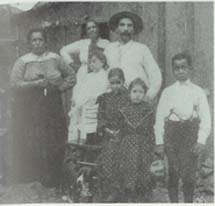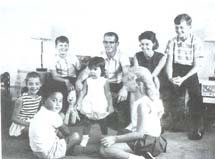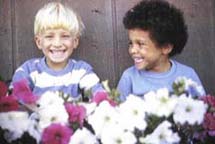
In 1904, the Mexican-American family shown here
adopted white orphans from New York through the Catholic church
in their Arizona mining town. These families conformed to religious,
but not to racial matching. Armed white
vigilantes removed the children and placed them in white Protestant
families instead. Transracial adoptions might occur when children
of color were inadvertently placed with white parents, but the reverse
was unthinkable and intolerable.

This publicity photo is from Louise Wise Services,
an innovative New York agency. Its Interracial Adoption Program,
established in 1953, concentrated on finding matching
parents for children of color, but transracial placements were made.

Small-town Oregonians Doug and Gloria
Bates adopted two biracial girls, Lynn and Liska, in the early 1970s
after having two sons, Steve and Mike. In his touching narrative
about their lives, Gift Children, Doug Bates described
how their naive faith in racial harmony was transformed over time,
like the country around them. “My spouse and I have no illusions
about tidy, fairy-tale endings, and life continues to mix our blessings
with setbacks. Like America, we are somewhat more cynical today,
a little less idealistic, a lot more world-weary than we were back
in 1970 when we thought we could handle just about anything life
chose to send our way.”
|
|
Placement across racial lines—which
almost always involved non-white children and white adults—challenged
matching by suggesting that visible
difference was compatible with love and belonging. During the first
half of the century, anecdotes about children of color accidentally
placed with white parents circulated in journalism, fiction, and
professional literature. With few exceptions, these stories were
considered tragic and shocking. The problem of racial mixups in
adoption illustrated an important point. Most Americans believed
in the naturalness of race-matching, but race-matching could be
very difficult to achieve, so it was not at all natural in the sense
of being automatic. In practice, color confusion was common, and
parents and social workers alike expressed deep concern about how
to categorize mixed-race children for the purpose of matching.
Making families inter-racial on purpose was the point of most
international adoptions
from Asian countries such as Korea, Japan, and Vietnam as well as
adoptions arranged by the Indian Adoption Project
after 1945. Attitudes toward these transracial placements reproduced
the historical color line in the United States, which was emphatically
black and white. White parents were more likely to accept “yellow,”
“red,” or even “brown” children. Those who
took in “black” children were considered the most transgressive.
After World War II, demographic pressures shaped this trend at least
as powerfully as civil rights ideology. New contraceptive technology
like the pill, legalized abortion after Roe v. Wade, and
the sexual revolution all decreased the supply of healthy white
infants, along with the stigma surrounding illegitimacy.
The result was that some white parents reconsidered their preference
for same-race adoptions.
Black children and white parents have always defined the debate
about transracial adoption, achieving a symbolic importance that
overshadowed their tiny numbers. After Loving v. Virginia,
a 1967 Supreme Court case that made laws prohibiting racial intermarriage
unconstitutional, some states, such as Louisiana, continued to ban
transracial adoptions. Family-making between blacks and whites was
invariably what these statutes aimed to prevent. Even at their peak
around 1970, perhaps 2,500 such adoptions were finalized each year,
and no more than 12,000 African-American children in all were placed
in white homes before 1975. Researchers, policy-makers, and child
welfare professionals carefully scrutinized these adoptions in hopes
of discovering whether inter-racial families helped or hurt children,
and how. Outcome studies rarely
showed that children’s development or identity were positively
harmed, but they still could not answer the most important question.
Was transracial adoption a socially desirable or undesirable policy
in a society dedicated to pluralism but also polarized by racial
strife?
Determined would-be parents were usually the impetus in the first
black-white adoptions. Interestingly, they often lived in overwhelmingly
white parts of the country. The first recorded adoption of an African-American
child placed in a white home took place in Minnesota in 1948. In
Washington, a white couple, the Johnstons,
took an African-American child into foster
care in 1944, when she was only six weeks old, and adopted her—against
the advice of their social worker—when she was nine. Campaigns
during the 1950s to promote African-American
adoptions inspired other white couples to inquire about transracial
adoption. Worn down by the discrimination that made it difficult
to find enough same-race parents for all the children of color in
need, a few agencies began cautiously placing mixed-race and African-American
children in white homes. Some, but not all, of these families became
targets of violence and harassment. A program of the Children’s
Home Society of Minnesota called PAMY (Parents to Adopt Minority
Youngsters) found that its first such placements in the early 1960s
were blessedly uneventful. Transracial adoptions were only a “little
revolution,” concluded project director Harriet Fricke, in
relief. Black children were kin, not projects in racial reconciliation
or pawns in racial conflict.
The debate about transracial adoption changed course in 1972,
when the National Association of Black Social Workers issued a statement
that took “a vehement stand against the placements of black
children in white homes for any reason,” calling transracial
adoption “unnatural,” “artificial,” “unnecessary,”
and proof that African-Americans continued to be assigned to “chattel
status.” The organization was so committed to the position
that black children’s healthy development depended on having
black parents that its President, Cenie J. Williams, argued that
temporary foster and even institutional placements were preferable
to adoption by white families. This opposition slowed black-white
adoptions to a trickle. In 1973, the Child
Welfare League of America adoption standards, which had been
revised in 1968 to make them slightly friendlier to transracial
adoption, were rewritten to clarify that same-race placements were
always better. The child welfare
establishment never supported transracial adoptions.
A number of new agencies, staffed almost entirely by African Americans,
such as Homes for Black Children
in Detroit and Harlem-Dowling Children’s Service in New York,
renewed the effort that had started in the late 1940s and 1950s
to find black homes for black children. In spite of successful efforts
to boost the numbers of black adoptive families, objections to whites
adopting African-American children were never translated into law.
Minority group rights to children were legally enforceable only
in the case of Native American children, and only after the 1978
passage of the Indian Child Welfare Act.
Since 1972, the numbers of black-white adoptions have declined,
but this may have as much to do with stubborn private preferences
and prejudices among white adopters as with organized opposition
or public policies that created new barriers to transracial placements.
International adoptions,
after all, increased quite dramatically at just the moment when
the transracial adoption of African-American children was becoming
controversial. They continued to accelerate throughout the 1970s,
1980s, and 1990s, when Americans adopted more than a quarter of
a million foreign children. International placements have increased
much more dramatically than domestic transracial adoptions. Why?
There are many reasons, but a simple one stands out. Most children
have come from Asia, Eastern Europe, and Latin America. They did
not represent the specific kind of difference that had bothered
Americans and had tortured their history most. Children adopted
from overseas were not black.
|



